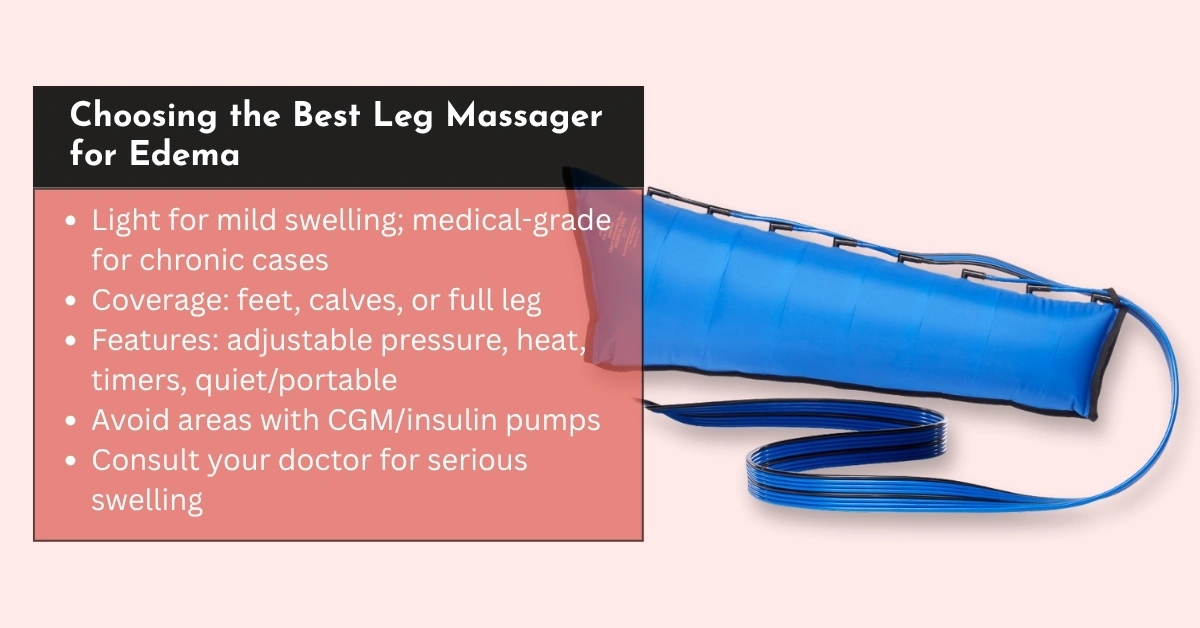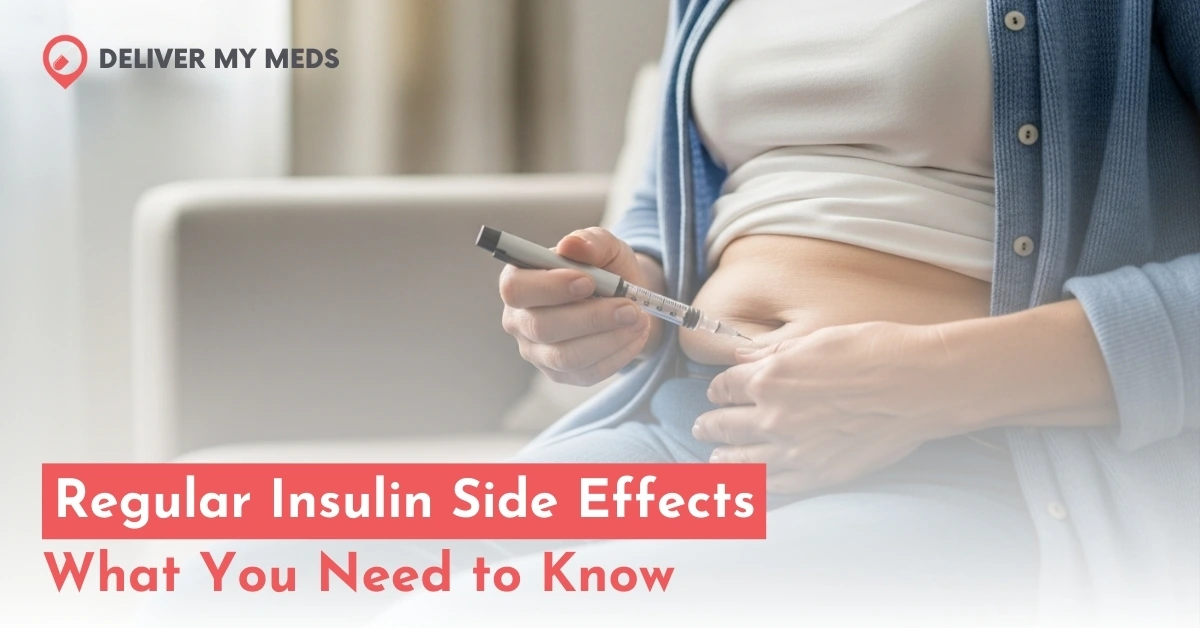
Swelling in the legs, ankles, or feet can come from different issues. Edema and lymphedema are two of the most common, but they’re quite different in how they start and how you treat them. They happen for different reasons and need different treatment methods. If your legs swell up after surgery or due to a long-term issue, the right leg massager for edema might ease the pain and help you move around more comfortably.
In this guide, we’ve explained everything you need to know if you’re dealing with leg swelling, mild edema, or lymphedema. We’ve broken down the difference between the two, how leg massagers work, what features matter, and listed 16 of the best options including DMM’s medical-grade options and more.
Understanding the Difference Between Edema and Lymphedema
Both conditions can cause swelling, especially in the legs, but they don’t come from the same problem.
- Edema is usually short-term and linked to things like sitting too long, certain medications, pregnancy, or minor circulation issues.
- Lymphedema, on the other hand, is a long-term issue. It happens when the lymphatic system gets damaged, often after cancer treatments or surgery, and the swelling doesn’t go away on its own.
Symptoms
- Leg heaviness or stiffness
- Skin tightness and puffiness
- Swelling that doesn’t go away with rest
- Increased risk of infections (especially with lymphedema)
Treatment
1. Edema:
- Elevation of legs
- Regular movement
- Use of home leg compression massagers
2. Lymphedema:
- Physician-supervised car
- Use of DMM pneumatic compression pumps
- Compression garments
Note: Not sure how lymphedema is different from edema? We’ve explained it clearly in our guide, including causes, symptoms, and treatment options.
How Leg Massagers Help Manage Edema
Leg massagers help reduce swelling by improving blood circulation and moving trapped fluid from the legs back toward the upper body. Depending on the type, they work in different ways:
- Air Compression: Gently squeezes the legs in cycles to mimic natural lymph drainage.
- Vibration & Kneading: Stimulates muscles and soft tissue to reduce tightness and puffiness.
- Heat Therapy: Opens up vessels, boosts blood flow, and supports fluid release.
DMM’s Recommendation: We offer clinically backed compression systems designed for people managing chronic edema. If you’re unsure which device fits your condition or insurance, our team can guide you personally.
Key Features to Evaluate Before Buying
| Feature | Considerations |
| Type | Choose between air compression, shiatsu, vibration, or heat + massage combos |
| Coverage Area | Foot-only, calf-only, or full-leg sleeves |
| Adjustability | Levels of pressure, heat control, massage modes, and session timers |
| Size & Fit | Adjustable wraps to fit various calf or thigh diameters |
| Portability | Compact units vs. stationary medical pumps |
| Medical Certification | FDA clearance |
| Insurance Eligibility | Available for DMM medical pumps with appropriate documentation |
16 Best Leg Massagers for Edema Relief
Air Compression (Gentle to Clinical-Grade)
1. SC 4004 DL 4-Chamber Compression System
This FDA-cleared SC 4004 DL 4-Chamber device offering targeted compression therapy for lymphedema and chronic edema, with customizable compression cycles.
2. SC 4008 DL 8-Chamber Advanced Pump
Clinic-grade, programmable SC 4008 DL 8-Chamber system delivering sequential leg compression across multiple zones for home-based medical use.
3. SC 2004 DL Lightweight Clinical Compression
Durable leg compression device designed for post-op swelling, long-term edema, or insurance-supported home therapy.
4. Full-Leg Compression Wrap with Heat and 3 Intensity Levels
Covers the entire leg with adjustable pressure and optional heating, ideal for daily swelling relief and comfort care
5. Foot and Calf Compression Unit with Warming Function
Dual-mode setup that delivers gentle massage and heat therapy to support lower limb circulation and mild swelling.
6. Multi-Pressure Leg Massager with LCD Remote
Advanced control system with targeted air chambers to improve blood flow and reduce fluid buildup.
7. Customizable Full-Leg Massager for Foot, Calf, and Thigh
Adjustable compression intensity for multi-zone massage, combined with warming features for total leg care.
Vibration & Shiatsu Systems (Targeted Rolling Massage Relief)
1. Deep Kneading Massager with Heat and Elevation
Focuses on foot massage and fluid movement, combining heat and incline for tired, swollen feet.
2. Foot and Leg Roller Massager with Compression
Blends kneading rollers and gentle compression for a deeper, more stimulating leg massage.
3. Vibrating Compression Massager for Circulation Support
Low-pressure vibration and compression to ease fluid retention and promote microcirculation in the legs.
Note: The DMM SC Compression Pumps (4004 DL, 4008 DL, 2004 DL) with garments Full-leg (thigh-to-foot) are specifically engineered for clinical lymphedema, persistent edema, and home users who require long-term, durable equipment that may qualify for insurance coverage.
Consumer vs. Medical-Grade: Side-by-Side Comparison
| Feature | Consumer Massagers | DMM Medical-Grade Pumps |
| Use Case | Mild swelling, tired legs | Chronic edema, lymphedema, post-surgery |
| Pressure Range | Approximately 50-60 mmHg | Up to 100 mmHg, adjustable |
| FDA Clearance | Rare | Yes, cleared for clinical use |
| Durability | 6-12 months | 3-5 years, clinic-grade build |
| Insurance Coverage | Not eligible | Often covered with medical documentation |
How to Choose the Best Leg Massager for Edema
The most suitable device depends on your diagnosis, treatment goals, and medical supervision.
• Severity of Swelling:
Use light massagers for occasional puffiness. For chronic edema or lymphedema, choose medical-grade pumps.
• Anatomical Focus:
Devices vary in coverage. Some are limited to the feet or calves, while others provide full-leg compression. Selection should reflect the location of swelling and clinical recommendations.
• Key Features:
- Adjustable pressure
- Heating function
- Session timers
- Quiet operation or portability if needed
- Compatibility with Medical Devices: People using CGMs or insulin pumps must avoid compression on insertion zones.
- Medical Guidance: Always consult a physician for moderate-to-severe swelling or diagnosed lymphedema.
Medical-Grade Compression Systems
These compression systems offer physician-level therapy in a home setting. They’re durable, customizable, and eligible for insurance reimbursement.
Safety Tips and Best Practices in Edema and Lymphdema
• Avoid Use If You Have:
- Deep vein thrombosis (DVT)
- Open wounds or skin ulcers
- Active infections or cellulitis
- Severe congestive heart failure (CHF)
• For CGM/Pump Users:
- Never compress over insulin pump or CGM sites
- Use soft padding if compression zones are nearby
Conclusion
The right leg massager for edema relief can make a major difference in swelling reduction, circulation, and everyday comfort. For minor symptoms, consumer-grade devices are often enough. But if you’re living with chronic edema or lymphedema, DMM’s SC Series medical pumps offer durable, insurance-compatible solutions trusted by physicians. From heat and vibration units to clinical pneumatic systems, there’s a safe, effective option available to support your recovery.




